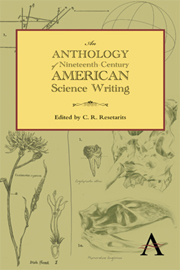Book contents
- Frontmatter
- Contents
- Preface
- Part One 1800–1846 Naturals and Naturalists
- Part Two 1846–1876 Warriors
- Part Three 1876–1900 Scientists
- Part Three Introduction
- “The Fixation of Belief” (excerpt), Popular Science Monthly (1877)
- “How to Make Our Ideas Clear” (excerpt) Popular Science Monthly (1878)
- “Catastrophism and Evolution” (excerpt), The American Naturalist (1877)
- “The Spectrum of an Argand Burner,” Science (1883)
- “The New Astronomy. I. Spots on the Sun” (excerpt), The Century (1885)
- “Screw,” Encyclopedia Britannica, vol. 21, 9th edition (1875–1889)
- “On the Relative Motion of the Earth and the Luminiferous Ether,” American Journal of Science (1887)
- “The Lake as a Microcosm” (excerpt), Bulletin of the Peoria Scientific Association (1887)
- “Laws of Temperature Control of the Geographic Distribution of Terrestrial Animals and Plants,” National Geographic Magazine (1894)
- “The Ecological Relations of the Vegetation on the Sand Dunes of Lake Michigan” (excerpt), Botanical Gazette (1899)
- “On the Equilibrium of Heterogeneous Substances, abstract,” American Journal of Science and Arts (1878)
- Bibliography
“The Spectrum of an Argand Burner,” Science (1883)
from Part Three - 1876–1900 Scientists
Published online by Cambridge University Press: 05 June 2012
- Frontmatter
- Contents
- Preface
- Part One 1800–1846 Naturals and Naturalists
- Part Two 1846–1876 Warriors
- Part Three 1876–1900 Scientists
- Part Three Introduction
- “The Fixation of Belief” (excerpt), Popular Science Monthly (1877)
- “How to Make Our Ideas Clear” (excerpt) Popular Science Monthly (1878)
- “Catastrophism and Evolution” (excerpt), The American Naturalist (1877)
- “The Spectrum of an Argand Burner,” Science (1883)
- “The New Astronomy. I. Spots on the Sun” (excerpt), The Century (1885)
- “Screw,” Encyclopedia Britannica, vol. 21, 9th edition (1875–1889)
- “On the Relative Motion of the Earth and the Luminiferous Ether,” American Journal of Science (1887)
- “The Lake as a Microcosm” (excerpt), Bulletin of the Peoria Scientific Association (1887)
- “Laws of Temperature Control of the Geographic Distribution of Terrestrial Animals and Plants,” National Geographic Magazine (1894)
- “The Ecological Relations of the Vegetation on the Sand Dunes of Lake Michigan” (excerpt), Botanical Gazette (1899)
- “On the Equilibrium of Heterogeneous Substances, abstract,” American Journal of Science and Arts (1878)
- Bibliography
Summary
I have been lately requested to determine the distribution of energy in the spectrum of an argand burner, and have been able to do this by means of the apparatus and methods previously employed at the Allegheny observatory for mapping the invisible spectrum of the sun. The results are curious; and, in the hope that they may also be found useful, I desire to communicate them to the academy. The difficulty is such a determination lies in the mapping of something which is wholly invisible; and it has not been made before, I presume, in spite of its economical importance, because there has been no means known of measuring this invisible energy, except in a rough way, by the thermometer or themopile, by a process which gives incomplete results.
It was my object not merely to indicate how much of the radiation from a gas-burner was visible, and how much was not, but to give a map of its distribution on the normal or wave-length scale, which would enable any one to see the quality and amount of the energy in each part of the light and head region.
The ordinary argand burner, burning common house-gas within a glass chimney, was first placed at the centre of the curvature of a large Rowland concave grating; and, but means of the bolometer, the head was measured at successive points in the spectrum down to a wave-length of about.001 mm., where the overlapping second spectrum began to be sensible.
- Type
- Chapter
- Information
- An Anthology of Nineteenth-Century American Science Writing , pp. 229 - 233Publisher: Anthem PressPrint publication year: 2012



